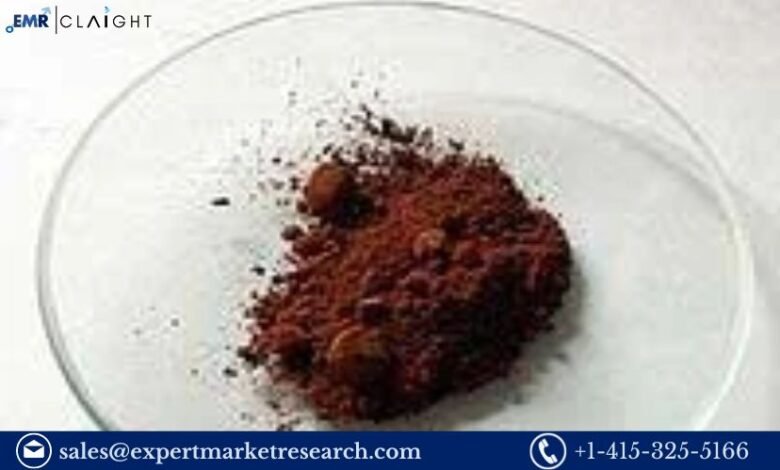Cadmium Oxide Manufacturing Plant Project Report 2024: Market Trends and Cost Analysis
Cadmium Oxide Manufacturing Plant Project Report

Introduction
Cadmium oxide is an important industrial compound with applications in a variety of sectors, including the manufacturing of batteries, ceramics, and pigments. Due to its unique properties, cadmium oxide is used in specialized applications, such as in photovoltaic cells, electroplating, and catalysts. As the demand for cadmium oxide continues to grow, setting up a manufacturing plant for this compound presents a valuable business opportunity. This article provides a detailed Cadmium Oxide Manufacturing Plant Project Report, outlining the production process, critical considerations, and answers to frequently asked questions for anyone interested in the cadmium oxide industry.
Overview of Cadmium Oxide and Its Uses
Cadmium oxide is an inorganic compound with various industrial applications. It is typically produced as a brown, amorphous powder or in crystalline form. Cadmium oxide is widely used in the following applications:
- Battery Manufacturing: Cadmium oxide is a primary component in nickel-cadmium (NiCd) batteries, where it serves as the positive electrode material.
- Ceramics and Glass: It is used to produce certain colored glass and ceramic glazes, giving them distinctive colors and durability.
- Pigments: Cadmium oxide is used as a pigment in plastics and paints, contributing to bright, stable colors that resist fading.
- Electronics and Photovoltaics: The compound is used in thin-film photovoltaic cells and in electroplating due to its conductivity and durability.
- Catalysts: Cadmium oxide serves as a catalyst in various chemical reactions, particularly in organic synthesis.
While cadmium oxide is valuable for these applications, it is a hazardous material that requires careful handling and regulatory compliance.
Get a Free Sample Report with Table of Contents @
Overview of the Cadmium Oxide Manufacturing Process
Manufacturing cadmium oxide involves the oxidation of cadmium metal or cadmium compounds. Here’s a simplified overview of the production process:
- Raw Material Preparation: The process begins with cadmium metal or cadmium carbonate as the primary source. These materials are carefully sourced and prepared to ensure high purity and consistency.
- Oxidation Process: Cadmium metal or cadmium carbonate is heated in the presence of oxygen to produce cadmium oxide. The reaction typically occurs at high temperatures and must be carefully controlled to avoid excess emissions and ensure safety.
- Purification and Filtration: After the reaction, the cadmium oxide is purified to remove any impurities. Filtration and other separation techniques are used to achieve the desired purity level, depending on the intended application.
- Grinding and Milling: The cadmium oxide is often ground or milled to achieve a fine powder consistency, which is suitable for battery and pigment applications. This step may vary depending on the physical properties required for the final product.
- Packaging and Storage: Once processed, the cadmium oxide is packed in secure, moisture-resistant containers to prevent contamination and degradation. Proper labeling and safety instructions are included to ensure safe handling during storage and transportation.
Throughout the process, strict controls and monitoring are essential to ensure product quality and safety, particularly given the toxic nature of cadmium oxide.
Key Considerations for Setting Up a Cadmium Oxide Manufacturing Plant
Establishing a cadmium oxide manufacturing plant requires addressing several key factors to ensure safe and efficient operations:
- Location: The plant should be situated in an area that meets regulatory requirements for handling hazardous materials. Proximity to suppliers of cadmium metal or cadmium compounds can reduce transportation costs. Additionally, the location should have access to transportation networks for distributing the final product.
- Technology and Equipment: Cadmium oxide production requires specialized equipment, including furnaces for oxidation, grinding mills, and filtration systems. Investing in automated monitoring and control systems can improve efficiency and safety by ensuring that reaction conditions remain stable and contaminants are minimized.
- Labor and Workforce: A skilled workforce is essential for handling cadmium oxide safely. Employees should be trained in chemical handling, equipment operation, and quality control. Regular training programs help workers stay up-to-date on best practices, safety protocols, and regulatory compliance.
- Safety and Environmental Considerations: Cadmium oxide is a hazardous material, so strict safety protocols are necessary. Proper ventilation, personal protective equipment (PPE), and fire suppression systems are essential for maintaining a safe working environment. Environmental considerations include waste management and emissions control systems to prevent pollution and comply with local regulations.
Financial Considerations and Cost Overview
Setting up a cadmium oxide manufacturing plant requires a substantial financial investment. Key cost components include land acquisition, facility construction, equipment purchase, and workforce training. Ongoing operational expenses include raw materials, energy, waste management, and regulatory compliance. Proper budgeting and financial planning are essential for managing these costs and ensuring the plant’s long-term profitability.
Investing in efficient equipment and sustainable production methods can help reduce operational costs over time. Additionally, implementing waste management and emissions control systems can enhance environmental compliance and minimize potential fines or penalties.
Market Potential and Industry Trends
The market for cadmium oxide is driven by demand from various sectors, particularly battery manufacturing and ceramics. Key trends in the industry include a focus on high-purity cadmium oxide for applications that require precise chemical compositions, such as photovoltaic cells. Additionally, there is growing interest in sustainable production practices and improved safety measures due to environmental and health concerns associated with cadmium compounds.
Understanding these trends can help businesses identify growth opportunities and align their production strategies with market demands. The demand for cadmium oxide is expected to remain steady, particularly in niche applications such as NiCd batteries and specialty ceramics.
Steps to Implement the Project
The process of establishing a cadmium oxide manufacturing plant generally follows these phases:
- Planning and Permitting: This initial phase involves selecting a suitable site, obtaining necessary permits, and ensuring compliance with environmental and safety regulations. A detailed project plan helps define the scope, timeline, and budget for the project.
- Facility Construction and Equipment Setup: Once planning is complete, the construction phase begins. This includes building the facility and installing specialized equipment for oxidation, purification, and grinding.
- Testing and Training: After construction, the equipment undergoes testing to ensure it operates correctly. Employees receive training on equipment operation, safety protocols, and quality control measures to ensure they can work safely and efficiently.
- Operational Readiness: The final stage involves preparing the plant for full-scale production. Quality control systems are put in place, and production processes are fine-tuned to ensure that the plant meets its output and quality goals.
FAQs
- What are the main uses of cadmium oxide?
Cadmium oxide is used in the manufacturing of NiCd batteries, ceramics, pigments, photovoltaic cells, and as a catalyst in various chemical reactions. - How is cadmium oxide produced?
Cadmium oxide is produced by oxidizing cadmium metal or cadmium carbonate in the presence of oxygen. The reaction occurs at high temperatures and is carefully controlled to ensure safety and quality. - What are the safety considerations for a cadmium oxide manufacturing plant?
Safety considerations include proper ventilation, personal protective equipment, fire suppression systems, and strict adherence to regulatory guidelines. Cadmium oxide is toxic, so handling it safely is essential. - What are the environmental considerations for a cadmium oxide plant?
Environmental considerations include managing waste, controlling emissions, and complying with local regulations. Proper waste disposal systems and emissions control technologies help reduce the plant’s environmental impact. - What factors affect the cost of setting up a cadmium oxide manufacturing plant?
Key cost factors include land acquisition, facility construction, equipment purchase, labor, raw materials, and regulatory compliance. Effective financial planning can help manage these costs and support long-term profitability.
Related Reports
fraud detection and prevention market
spain residential real estate-market
remote sensing software market
Media Contact:
Company Name: Claight Corporation
Contact Person: Lewis Fernandas, Corporate Sales Specialist — U.S.A.
Email: sales@expertmarketresearch.com
Toll Free Number: +1–415–325–5166 | +44–702–402–5790
Address: 30 North Gould Street, Sheridan, WY 82801, USA
Website: www.expertmarketresearch.com
Aus Site: https://www.expertmarketresearch.com.au


